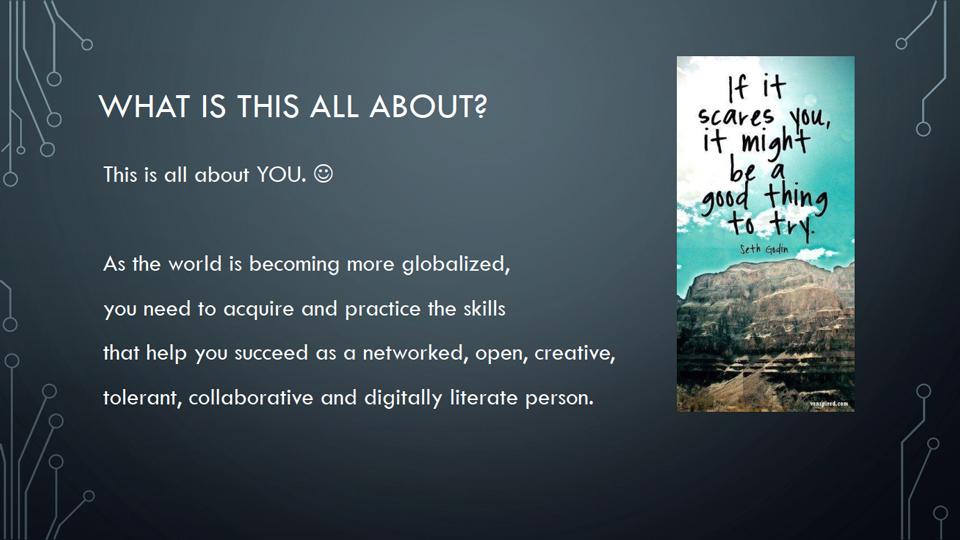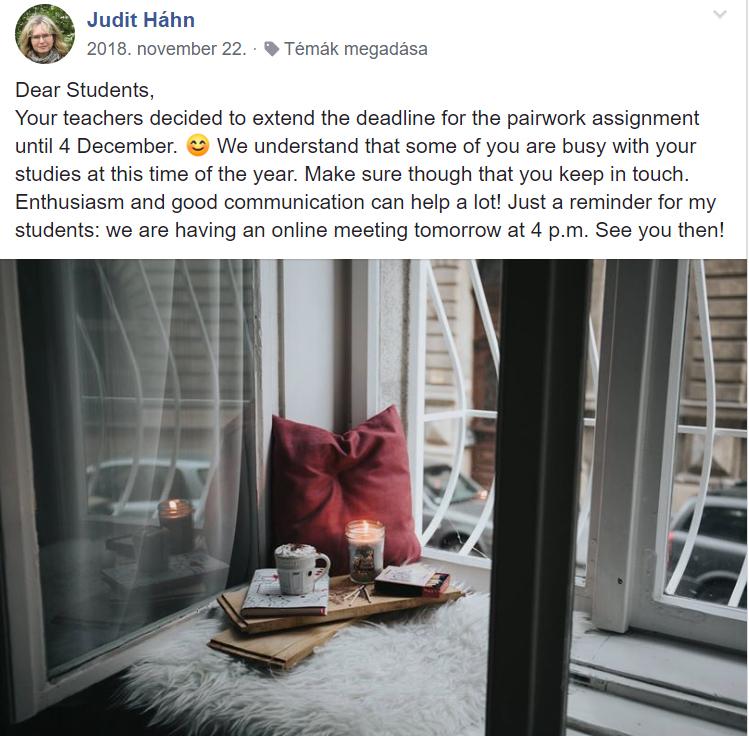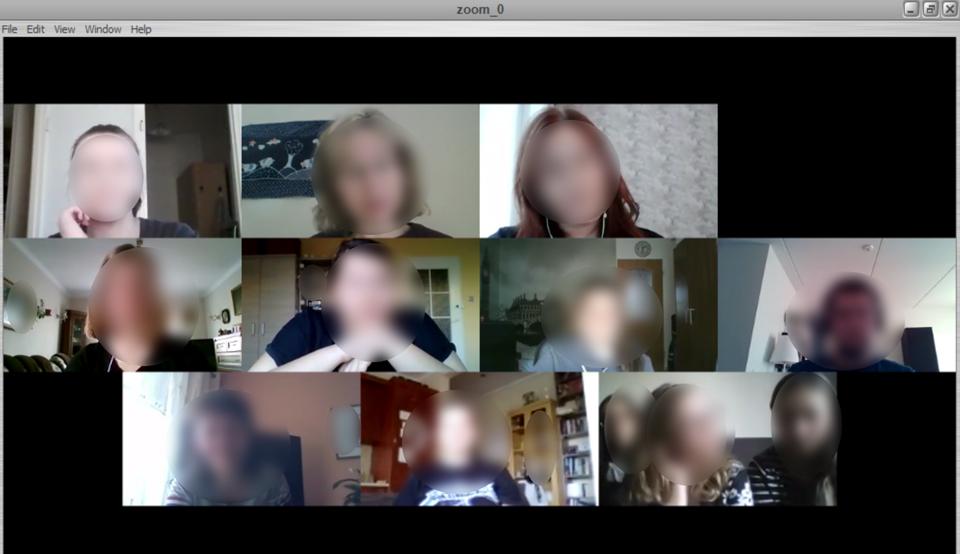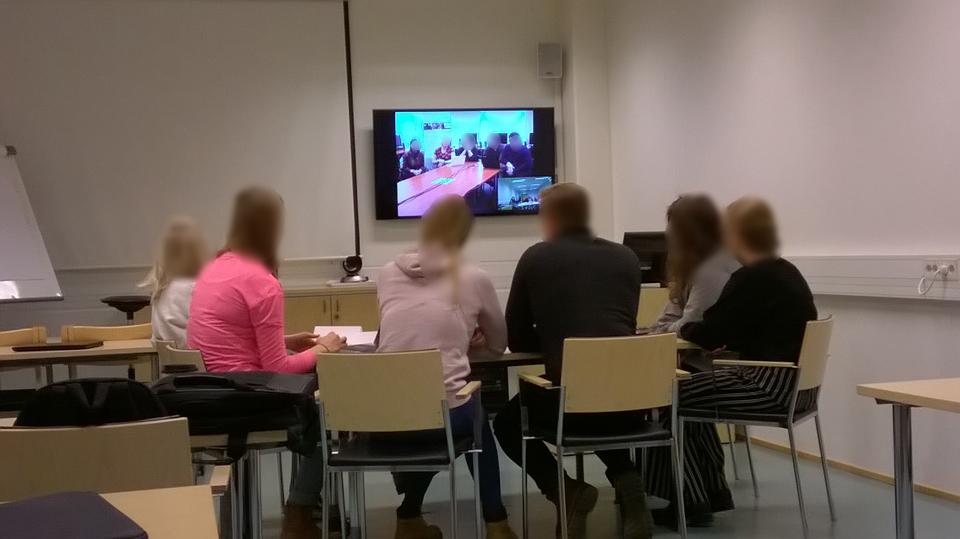
Judit Háhn
Virtual Exchange (VE) offers unique educational experiences at the intersection of the digital, the social, and the intercultural. It re-situates learning by creating an inclusive transnational learning space, where the participants move across and beyond cultural, curricular and individual boundaries.
Need for an inclusive, global mindset
The Virtual Exchange Coalition and the European Commission’s report on Erasmus+ VE initiatives define Virtual Exchange as “technology-enabled, sustained, people-to-people education programme” (European Commission, 2017, pp. 26–27), in which “the deep impact of cross-cultural exchange is combined with the broad reach of new media technologies” (Virtual Exchange Coalition, 2019). In practical terms, the students from different countries engage in intercultural dialogues and in online group collaboration as part of educational projects, which are facilitated by their teachers (O’Dowd, 2018; Baroni et al., 2019).
In the past five years, I have arranged ten VE projects with five foreign universities. My motivation was to equip my students with 21st century skills, which are valued in the world of work, such as problem solving, social and cross-cultural interaction, critical thinking, collaboration and digital literacy (Chu et al., 2017). Higher education curriculums tend to emphasize the development of such competencies, but less attention is paid to the actual realization of these learning outcomes. After getting inspired by the videoconferencing practices of Haaga-Helia University of Applied Sciences during an Erasmus exchange visit to Helsinki, I started planning joint VE teaching projects with dedicated colleagues from abroad.
The development of a global mindset (Andresen & Bergdolt, 2016) can foster inclusive attitudes. Since the students are working in international teams, they are exposed to diverse practices of communication, language use, and behavior. It is during group work when they realize that not only practices but also expectations might differ, for example, regarding politeness or time management. In order to complete the tasks by the deadlines, the group members need to embrace and manage the diversity in a productive way. As pointed out by Helm and Guth (2018), the aim of VE is “to equip the learners to participate together in a global society”. During these projects, the students can acquire strategies and concepts to address complexity, difference and uncertainty (Helm & Guth, 2018). With support available from the teachers, VE offers a safe playground for raising the students’ awareness of the importance of flexibility, openness, and socio-emotional presence. This is an exciting but at the same time challenging learning path, where the students learn not only about others but also about themselves (see Figure 1).

Transnational learning spaces
My students are English majors (teacher trainees or language specialists) at the University of Jyväskylä, Finland. Their excellent foreign language skills enable them to engage in professional and academic dialogues with peers from abroad. Although the university offers good opportunities for exchange visits to foreign countries, physical mobility does not suit all the students for financial, family, work or other (e.g. personal or health) reasons. Virtual Exchange addresses this challenge, as it is a cheap and accessible option for everyone who is interested in intercultural encounters and online collaboration.
In VE, the learning space situates itself in a transnational, interpersonal and digital environment. As pointed out by Middleton (2018, p. 8), the use of the digital “creates a constant pervasive and augmented learning experience”, and helps to reimagine learning spaces in higher education as “authentic and reflecting the world beyond campus” (ibid., p. 7). The use of digital tools removes national, institutional and curricular borders by making students meet in shared and informal online spaces. This establishes the student-centredness of VE: the students work in small teams, while the teachers act as facilitators (Háhn & Podlásková, 2016; 2018). VE can (and is often) integrated into face-to-face teaching, as part of curricular courses, creating blended learning environments. The physical classroom in this case is the place for preparation, reflective discussion, presentation, consultation, and feedback.
In accordance with the Universal Design of Learning (Padel et al., 2017), multiple means of representation, action, expression and engagement can feature in VE practices (see TEAL, 2010). The overall project description and the instructions are shared with the students in multiple ways. The teachers introduce them orally in class (for example, in a briefing session or in an opening videoconference) and also share them in digital format in a joint online platform. To increase the teachers’ immediacy and social-emotional presence, images and emoticons are often added to the instructions (see Figure 2). The students are encouraged to take advantage of multimodal communication; in the main assignment, they can express and demonstrate their knowledge in the form of videos, posters, presentation slides, videoconferences, reflection reports, pictures etc.

Each VE project has its own, overall theme, but within that, the groups can select the specific topic that they want to investigate and the way they want to explore it. The students also get autonomy in dividing the work in their virtual teams. This often requires reaching a compromise after some negotiation, but this way the students become more aware of the existence of diverse needs and abilities. They also learn how to create and maintain trust as part of a team. The teachers are available for support and advice all the time, but they intervene only if needed.
In addition, VE projects offer autonomy for the students in selecting the tools for online communication and collaboration. Based on the teachers’ recommendations, the members in a small group can decide what communication channels, apps and platforms they find best, on condition that the tools suit everyone’s needs. As most of the work is done online, the students can design their own schedules and work from locations where they feel comfortable. Although the main assignments need to be submitted by deadlines, between those dates the teams can proceed according to their own rhythm. The times of the synchronous video meetings (e.g. opening and closing meetings for all the participants, see Figure 3) are negotiated among the teachers and the students, considering the time zone differences and the technology available.

The Pedagogical Design
Before describing my projects, I find it important to differentiate between VE and Virtual Mobility (VM, see EADTU, 2019; and the website of Open Virtual Mobility) because they are often used as synonyms. Although both arrangements support internationalization at home, VE has a freely adoptable, flexible pedagogical design, independent from institutional agreements, while VM is built on partnership agreements and/or joint educational programs between higher education institutions. VE focuses more on individual learning and development, by encouraging intercultural dialogues, enhancing critical thinking and media literacy (Helm & Guth, 2018). Usually it is up to the units (e.g. university departments) to decide to what extent they hold it a priority to support VE in the curriculum or as part of course syllabuses.
At my university, the Department of Language and Communication Studies encouraged me to arrange VE as part of my courses or even as independent projects for credits. Between 2014 and 2019, I worked together with wonderful colleagues from the following universities: Haaga Helia University of Applied Sciences (1 project), University of Pardubice, Czech Republic (5 projects), Waseda University, Japan (2 projects), Adam Mickiewicz University, Poland (1 project, facilitated by EVOLVE), and the National Institute of Education, Singapore (1 project). The results of the collaboration with the University of Pardubice were shared at conferences (see, for example Háhn & Podlásková, 2015) and were published in papers (Háhn & Podlásková, 2016; 2018; Háhn, 2018).
When planning a project, the teachers involved negotiated the pedagogical design months before the actual start. During our Skype meetings, we discussed the learning outcomes, the main topic, the tasks, the schedule, and the online learning environment(s). The schedule proved to be the most challenging aspect of the planning because the teaching periods usually did not overlap. Once the project got started, we were managing the workflow from the background by sending out instructions, deadline reminders and feedback. This arrangement was beneficial for the students as it made them concentrate on group work. The projects lasted for 6–8 weeks in general.
The participants from my university were mostly Bachelor students, enrolled in language teacher training or in language specialization. The peers from abroad were either from the same field of studies (e.g. in the case of Japan and Singapore) or from a different subject (e.g. business studies – Czech Republic, tourism – Poland, public administration – Czech Republic). The broad topic of each VE was decided by the teachers, e.g. “Language teaching practices in country X and country Y”, and the groups were asked to select a specific aspect (i.e. a subtopic) that they wanted to investigate.
In 2018, for example, the students explored and compared the role of English in Finland and in the Czech Republic. For my students, this was an assignment for the Sociolinguistics course, while the Czech students completed it for their Business English course. Two closed Facebook groups were created, each with 10–12 participants (e.g. 5 Finns and 7 Czechs). After some introductory and warm-up tasks, the students worked in pairs to collect and compare real life evidence for the use of English in a sociolinguistic domain (catering, media, advertising, tourism etc.) of their choice. The pairs summarized their findings in presentations (format freely chosen by the groups) that were shared before the room-based videoconferences (see Figure 4), where the students discussed the findings.

In another project, tourism majors from Poland and language students from Finland were working in groups of 4–5 to create promotional videos that jointly advertise their towns (Poznaň and Jyväskylä) for young people. Everyone could freely share ideas and contribute to the creation of the videos, but the students were asked to add their subject-specific expertise. This way the linguists provided support with the use of English, while the tourism experts shared their knowledge about city tourism marketing. The students created excellent videos utilizing their own recordings and pictures that they shot in their cities (see some of the students’ videos and more on this project in my teaching blog, see Háhn, n.d.).
The role of student feedback and reflection reports
To ensure the success of the initiative, student feedback and reflection reports were collected at the end of each VE. The teachers usually planned this evaluation process together, compiling a questionnaire and writing prompts/instructions for the reflection reports. The students’ answers were carefully studied and considered when planning the next project. In addition, most of the projects had a concluding or follow-up session at each university, where the students could discuss their experiences.
The class discussions, the students’ reports and the questionnaire answers revealed that most of the participants felt that VE was a unique, special and beneficial experience. Most of them found it rewarding to meet and work together with peers from another country and also welcomed the opportunity to try out digital tools for collaboration. They pointed out the initiative’s working life relevance and saw it as a wonderful opportunity to develop their soft skills and cross-cultural competencies. From 2018 onwards, in addition to the study credits, each of my students received a certificate about their VE participation. This was a one-page document, which summarized what the participants learnt and what tasks they completed. The students can use the certificate for example in applications for physical youth mobility and/or future jobs.
Conclusion and advice
Each VE is a unique experience. To ensure that it is rewarding for all the participants, the teachers involved need to be equally committed and motivated. Proper preparation is important to prevent (or at least to mitigate) some of the potential challenges of VE. Misunderstandings can arise if the participants do not get the same instructions and support from their teachers. There are very good trainings available for educators (see Erasmus+ VE and EVOLVE), which I highly recommend for those who would like to run such projects. Although it is time-consuming to arrange VE, there are many benefits for the educators involved. One can learn about new pedagogical approaches by co-teaching with an international colleague (Helm & Guth, 2018), which can be inspiring for developing online teaching and student-centred teaching practices.
For the students, the strength of VE as “an effective option to address challenges related to cultural awareness, intercultural collaboration and transversal/soft skills” (European Commission, 2017, p. 29) cannot be denied. Based on years of experience and student feedback, I am convinced that online international encounters have great potential to increase respect for cultural diversity, along with the development of other competences such as creative thinking, problem-solving, communication, collaboration and foreign language skills. It would be ideal if VE became a natural and widespread pedagogical design in various disciplines as part of higher education curriculums.
Author

Judit Háhn is a senior lecturer of English. She teaches courses on linguistics and discourse at the Department of Language and Communication Studies of the University of Jyväskylä, Finland. She is interested in discourse practices in virtual learning environments, digital literacies, language policy and online linguistic landscapes. In her teaching, she has arranged Virtual Exchange projects with partner universities from the Czech Republic, Poland, Singapore and Japan.
References
Andresen, M. & Bergdolt, F. (2016). A systematic literature review on the definitions of global mindset and cultural intelligence – merging two different research streams. The International Journal of Human Resource Management, 28(1), 170–195. https://doi.org/10.1080/09585192.2016.1243568
Baroni, A., Dooly, M., Pilar, G. G., Guth, S., Hauck, M., Helm, F., Lewis, T., Mueller-Hartmann, A., O’Dowd, R., Rienties, B., & Rogaten, J. (2019). Evaluating the Impact of Virtual Exchange on Initial Teacher Education: A European Policy Experiment. The EVALUATE Group. Research-publishing net. Retrieved August 23, 2019 from https://www.evaluateproject.eu/evlt-data/uploads/2019/03/EVALUATE_EPE_2019.pdf
Chu, K. W. S., Reynolds, R., Tavares, N., Notari, M. & Wing, Y. L. C. (2017). Twenty-First Century Skills and Global Education Roadmaps. https://doi.org/10.1007/978-981-10-2481-8
EADTU – European Association of Distance Teaching Universities. (2019). Innovative Models for Collaboration and Student Mobility in Europe. Results of EADTU’s Task Force and Peer Learning Activity on Virtual Mobility. May 2019. Retrieved August 23, 2019 from http://openaccess.uoc.edu/webapps/o2/bitstream/10609/93586/1/Innovative%20Models%20for%20Collaboration%20and%20Student%20Mobility%20in%20Europe.pdf
Erasmus+ Virtual Exchange. (n.d.). ABOUT ERASMUS+ VIRTUAL EXCHANGE. European Youth Portal. Retrieved August 23, 2019 from https://europa.eu/youth/node/54451_en
European Commission. (2017). Study on the feasibility of an Erasmus+ Virtual Exchange initiative. Final report. Study prepared by PPMI for DG EAC. Retrieved August 23, 2019 from https://eacea.ec.europa.eu/sites/eacea-site/files/tender-specifications_eve.pdf
EVOLVE. (n.d.). Evidence-Validated Online Learning through Virtual Exchange. Retrieved August 23, 2019 from https://evolve-erasmus.eu
Háhn, J. (2018). Virtual exchange: not only for language learning. Kieli, koulutus ja yhteiskunta, 9(7). Retrieved August 23, 2019 from https://www.kieliverkosto.fi/fi/journals/kieli-koulutus-ja-yhteiskunta-joulukuu-2018/virtual-exchange-not-only-for-language-learning
Háhn, J. (n.d.). Learn, Grow, and Teach. Professional blog on teaching and learning. Retrieved August 23, 2019 from https://judithahn.blogspot.com
Háhn, J., & Podlásková, I. (2015). Videoconferencing in ESP Classes: Learner-centred Approach. Joint presentation at the International Conference on Language Centres in Higher Education, Masaryk University, Brno, Czech Republic (15.2.2015). Retrieved August 23, 2019 from https://slideslive.com/38892986/videoconferencing-in-esp-classes-learnercentred-approach
Háhn, J., & Podlásková, I. (2016). Videoconferencing in ESP Classes: Learner-Centred Approach. CASALC Review, 5(2), 51–61. Retrieved August 23, 2019 from https://jyx.jyu.fi/handle/123456789/51602
Háhn, J., & Podlásková, I. (2018). Roles of the Learner in Videoconferencing. In L. Štěpánek, K. Sedláčková, & N. Byrne (Eds.), Videoconferencing in University Language Education (pp. 93–108). Brno: Masarykova univerzita.
Helm, F., & Guth, S. (2018). Erasmus+ Virtual Exchange and Internationalization at Home. Webinar of the Coimbra Group. Organized by the Education Innovation Working Group together with the Academic Exchange and Mobility Working Group and the eLearning Centre of the Jagiellonian University. Retrieved August 23, 2019 from https://www.youtube.com/watch?v=6mvIpm3NTiY
Middleton, A. (2018). Reimaging spaces for learning in higher education. London: Macmillan Teaching & Learning.
O’Dowd, R. (2018). From telecollaboration to virtual exchanges: state-of-the-art and the role of UNICollaboration in moving forward. Journal of Virtual Exchange, 1, 1–23. https://doi.org/10.14705/rpnet.2018.jve.1
Open Virtual Mobility. (n.d.). Online information portal on Accessible Opportunities for Virtual Mobility Skills in Higher Education. Retrieved August 23, 2019 from https://www.openvirtualmobility.eu
Padel, L., O’Connor, J., & Barrett, T. (Eds.) (2017). Universal Design for Curriculum Design: Case Studies from University College, Dublin. Dublin: Access and Lifelong Learning, University College Dublin.
TEAL – Teaching Excellence in Adult Literacy. (2010). Universal Design for Learning. TEAL Center Fact Sheet. Retrieved August 23, 2019 from https://lincs.ed.gov/sites/default/files/2_TEAL_UDL.pdf
Virtual Exchange Coalition. (2019). Retrieved August 23, 2019 from http://virtualexchangecoalition.org





